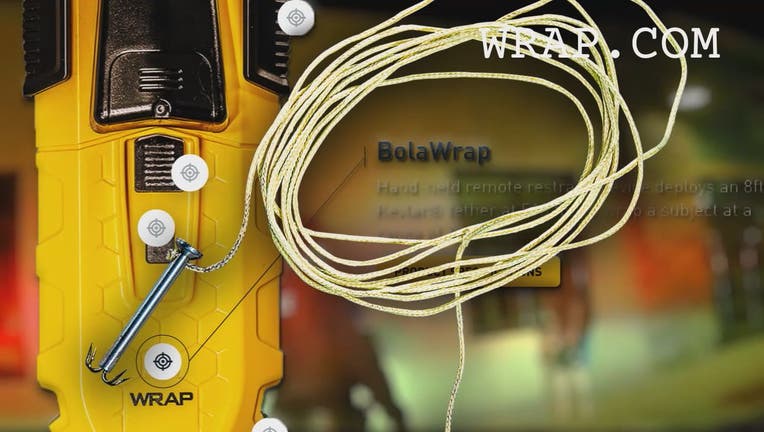Minnesota police explore BolaWrap as possible less lethal alternative

The Bolawrap is a device that shoots an eight-foot Kevlar rope that captures a suspect from a distance of 10 to 25 feet. (Wrap.com)
VIRGINIA, Minn. (FOX 9) - It looks like something Batman might carry on his utility belt: a device that shoots an eight-foot Kevlar rope that captures a suspect from a distance of 10 to 25 feet.
Known as the BolaWrap, it was used last month in Virginia, Minnesota to apprehend an unarmed man on a psych hold who walked away from the hospital.

Minnesota police explore BolaWrap as possible less lethal alternative
It looks like something Batman might carry on his utility belt: a device that shoots an eight-foot Kevlar rope that captures a suspect from a distance of 10 to 25 feet.
The man was immediately immobilized by the rope around his arms and abdomen, which allowed the police officers to safely handcuff him.
Virginia’s police chief, Nicole Young-Mattson, purchased the device for $1,500 after watching a demonstration at a police convention last year.
"I sat there after the demonstration and said, ‘This is phenomenal,'" she said.
Police calls involving the mentally ill, chemical addicted, or both, are considered some of the most dangerous and unpredictable for police. Crisis Intervention Training (CIT) has become common for police across the U.S.
"In split seconds you can be hands on fighting, using a Taser, or worse," said Chief Young-Mattson.
On Saturday, a St. Paul Police officer shot an unarmed and naked man. The officer was fired three days later.
"The BolaWrap is like throwing handcuffs on someone from a distance," said Tom Smith, CEO of WRAP, the Arizona company behind BolaWrap.
WRAP’s stock price on the NASDAQ exchange skyrocketed in the days after the police killing of George Floyd.
"If you look at all the protests since George Floyd, and what they’re asking for, they’re looking for a change," said Smith.
The BolaWrap is 80 to 90 percent effective at a distance of 10 to 25 feet, Smith said.
BolaWrap looks like something straight out of a comic book, but its inventor said he took inspiration from the bolas, or boleadoras, used by the Spanish to capture animals.
Smith is quite familiar with the market for less lethal force devices. Along with his brother they launched Taser 20 years ago. Smith resigned as CEO of Taser, now Axon, in 2012.
WRAP has an aggressive marketing campaign, enlisting free media coverage when the device is successfully used in a local television market. The company sent a story pitch this week to Twin Cities media citing the Virginia case.
Smith said the man in the Virginia case was slightly injured by one of the fishhooks attached to the Kevlar rope.
Officers are trained to aim for the area between the wrists and elbows, or even the legs of a suspect.
The Kevlar rope and hooks ejected from the device travel at 513 feet per second. To be effective, it requires eight feet of clearance. It is not recommended for tightly confined spaces, like a home interior.
Nearly 300 police agencies in 45 states are using the BolaWrap, the company said.
Minneapolis Police equipped 25 officers with BolaWraps last year as part of a pilot project. There were only two deployments, and both times it failed. The department is no longer using BolaWrap.
An MPD spokesperson said the device is less effective with a moving target.
Smith, Wrap’s CEO, said the BolaWrap occupies a middle ground between verbal de-escalation and using a Taser. But he readily admits it is not ideal for every situation.
"There is no magic bullet as much as we’d like to believe there is," said Smith.

